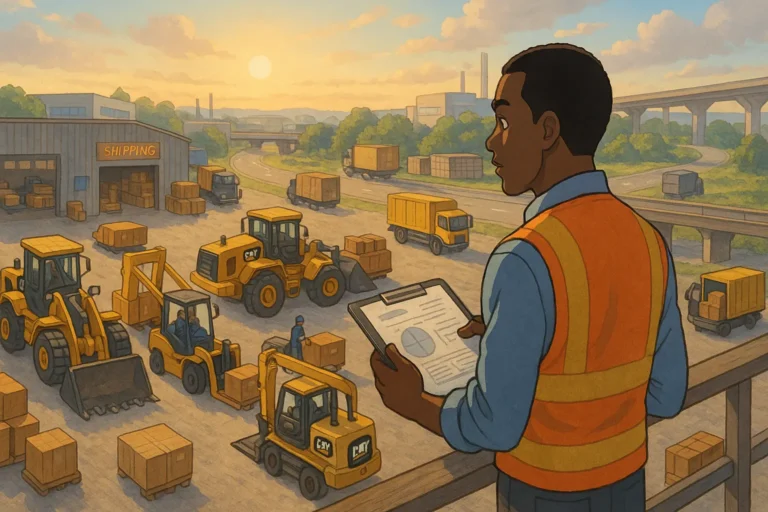
Building supply chain sustainability in Africa is necessary if we intend to preserve the resources and beauty of the continent. However, it takes the collective effort of both internal and external stakeholders to make this possible.
Sustainability is not a choice; it is our responsibility towards Africa’s future.
Introduction
Africa is rich in natural resources and a large population, making it an attractive destination for many businesses, locally and internationally.
That’s probably why more corporations and governments on the continent are turning to supply chain sustainability and business practices to maintain these perks.
It is one thing to want to implement sustainable practices, and it is another to do it right. Considering African supply chains’ challenges, it doesn’t take long to assume they will need unique solutions.
But….
What are these solutions, and how do they go about it? We will cover this and much more in this article, so keep reading.
Importance of Supply Chain Sustainability in Africa
Indeed, supply chain sustainability has been a touchy subject for most African businesses, especially because of the perceived myths of ethical supply chains on the continent.
It is too expensive, complicated, and disruptive for the supply chain, just to name a few. Despite all these, there are still contested benefits.
1. It meets the needs of all stakeholders, including customers, suppliers, and local communities.
2. Businesses get to reduce their carbon footprints, sparing the continent many more years and decades.
3. It can help your supply chain design, create, and deliver quality products to your consumers
4. Sustainable practices involve more people in the supply chain, which ultimately streamlines and increases the supply chain’s productivity.
Elements of Building Supply Chain Sustainability in Africa
There are typically three main elements of building a sustainable supply chain worldwide. In Africa, it is the same principles apply.
Environmental
The environment is a big part of the sustainability movement. Sustainable supply chains should strive to reduce their environmental impact by reducing greenhouse gas emissions, preserving resources, and supporting environmentally friendly activities.
In keeping with this, these supply chains could implement strategies for energy-efficient transportation, trash management, and recycling.
Economy
Sustainable supply chains should conform to circular economy principles, which aim to reduce waste while increasing resource efficiency.
These principles include developing long-term durability and recyclability products, implementing recycling and remanufacturing processes, and encouraging material reuse and repurposing.
Social
The people directly impacted by your supply chain matter. These people are usually the employees and other stakeholders within the supply chain. Employee well-being and fair treatment are prioritized in sustainability goals.
These include fostering safe working conditions, paying fair salaries, and supporting efforts promoting diversity and inclusion. Ensuring employee well-being and establishing a healthy work environment contribute to the supply chain’s sustainability.
Challenges of Building Supply Chain Sustainability in Africa
Building supply chain sustainability in Africa has not been not without its challenges, especially when compared to the rest of the world.
1. Africa is home to some of the most underdeveloped and politically unstable countries, which makes infrastructure a problem. With poor infrastructure, businesses are less concerned about sustainability than surviving.
2. Corruption is rampant in Africa, which makes doing business considerably more expensive than most other economies. Considering how people already think sustainability is expensive, selling sustainability to them becomes challenging.
3. African markets tend to be riddled with a lack of transparency, inadvertently making it challenging to identify reliable suppliers who align with sustainable goals.
Guide to Building Supply Chain Sustainability in Africa
# Developing a Sustainable Sourcing Strategy
Every great accomplishment starts with a measurable strategy. This is also true for building sustainable supply chains in Africa.
Developing a sustainable sourcing strategy is the first step in building a sustainable supply chain in Africa.
Developing strategies involves identifying suppliers that meet your sustainability criteria and are committed to operating sustainably and ethically.
To do this, you must thoroughly assess potential suppliers’ environmental impact, social responsibility, and economic performance.
You should also consider your operations’ social and economic impact and how they can be made more sustainable.
# Implementing Sustainable Practices in the Supply Chain
Once you have identified reliable suppliers, the next step is to implement sustainable practices throughout the supply chain.
These practices will include everything from reducing waste and energy consumption to ensuring that workers are treated fairly and paid a living wage.
You should also consider implementing certification schemes like Fairtrade or Rainforest Alliance to ensure your products are produced sustainably and ethically.
# Building Partnerships and Collaborations for Sustainability
Collaboration is the bedrock of the modern supply chain. This also impacts sustainability within the supply chain.
Building alliances and collaborations with vendors or suppliers is critical when developing sustainability through your supply chain.
You can share information and resources with suppliers through collaboration and harness their combined skills to achieve common goals.
Shared information could range from sharing best practices to working together on sustainability efforts.
# Measuring and Tracking Sustainability Progress
Finally, it is important to measure and track your sustainability progress.
Measuring and tracking your sustainability helps you identify how well your efforts are doing, but it is equally important to identify areas where you can do better.
It also helps you demonstrate your commitment to sustainability to relevant stakeholders, including customers, employees, suppliers, and investors.
To do this, you should establish clear sustainability metrics and targets and regularly monitor your performance against these targets.
Tools and Resources for Building Supply Chain Sustainability in Africa
You will need tools and resources to build sustainable supply chains in Africa. Here are some of them.
1. Sustainability Standards and Certifications
-
- Global Reporting Initiative (GRI)
- ISO 14001
- Fairtrade
2. Supply Chain Sustainability Assessments
-
- Supplier Self-Assessment Questionnaires
- EcoVadis
3. Supply Chain Traceability and Transparency
-
- Blockchain Technology
- Traceability Software
4. Environmental Impact Assessment Tools
-
- Life Cycle Assessment (LCA)
- Carbon Footprint Calculators
5. Collaboration Platforms and Initiatives
-
- United Nations Global Compact
- Supplier Engagement Platforms
6. Capacity Building and Training Programs
-
- Sustainability Workshops and Seminars
- Sustainable Supply Chain Certification Programs
7. Government and Non-Governmental Organizations (NGOs) Support
-
- African Development Bank (AfDB)
- United Nations Industrial Development Organization (UNIDO)
8. Industry Associations and Networks
- Sustainable Supply Chain Initiatives
- African Supply Chain Sustainability Network (ASCSN)
FAQs on Supply Chain Sustainability in Africa
Q1: How can African customers help to sustain supply chains?
Consumers can help to preserve African supply chains by making informed purchase decisions, purchasing items with eco-labels or certifications, supporting brands that adopt sustainable methods, and demanding transparency and responsibility from businesses.
Q2: Are there any African certifications or norms for sustainable supply chains?
Yes, different certifications and standards are in place to guide and examine Africa’s sustainable supply chains. ISO 14001 (environmental management), Fairtrade, Forest Stewardship Council (FSC), and Roundtable on Sustainable Palm Oil (RSPO) are a few examples.
Q3: How can African governments assist in creating long-term supply chains?
Governments may support sustainable supply chains by passing and enforcing environmental rules, encouraging sustainable corporate practices via incentives and subsidies, investing in infrastructure, and encouraging collaboration between the public and private sectors.
Conclusion
Building supply chain sustainability in Africa can be complex and quite challenging. However, it also allows African stakeholders, such as consumers, governments, and businesses, to create lasting social, economic, and environmental benefits.
By approaching sustainability in the continent with comprehensive and well-thought-out strategies, it is possible to build a supply chain that is both sustainable and profitable.

Obinabo Tochukwu Tabansi is a supply chain digital writer & ghostwriter helping professionals and business owners across Africa explore various strategies that work and learn from the success and failures of various supply chains across the globe. He also ghostwrites social content for logistics & supply chain businesses








